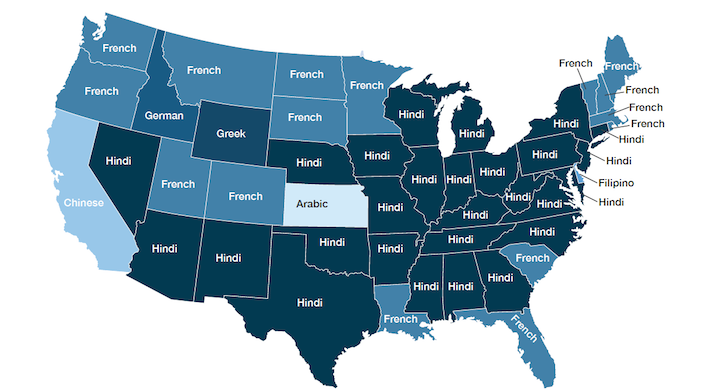Physicians Don't Always Talk Like the Locals
Doximity drew upon its vast network of physicians to undertake the study of language barriers in healthcare.

Most commonly-spoken languages by physicians in each state, other than Spanish and English.
Despite a growing number of bilingual physicians in the United States, some areas lack physician populations that reflect the languages spoken locally, according to a new study.
The report comes from Doximity, the physician social and professional network that claims about 70% of US doctors—more than 600,000—as members. Doximity derived the data from second languages self-reported on user profiles.
Researchers found that Washington, DC, has among the greatest disparities, said Joel Davis, the company’s vice president of products and analytics. Louisville, Kentucky; Minneapolis, Minnesota; Baltimore, Maryland; and Seattle, Washington, trailed close behind, according to the results.
“We did find a couple of cities where the alignment between physicians and patients on a proportionate level were pretty close,” Davis told Healthcare Analytics News™.
Speakers of languages from sub-Saharan Africa, southeast Asian, and parts of the Middle East are least represented among the physician population. Farsi, Hebrew, and Scandinavian dialects rounded out the top end of the over-represented languages across the country, according to Doximity.
Nearly half of doctors who speak a second language in the United States were foreign-trained, Davis said. Hindi, for example, is the language other than Spanish or English that physicians most commonly use.
Language barriers in medicine can be problematic when it comes to delivering accurate information to patients about their diagnosis or treatment. “Overall, patients with physicians who speak their language report better ‘interpersonal care’ comparable to that of patients who are proficient in English,” the report stated.
But this problem has several solutions. Interpreters, for example, could take on a larger role in healthcare. Now, about 38% of physicians have access to translators, Davis said.
Medical schools might also consider tackling the challenge. “Physician training could include more training in particular languages, specifically the ones where there are those disparities,” Davis added.
Although he noted that healthcare takes place on the local level, national policy could impact these disparities.
Rules governing immigration, for instance, could change the situation. “As immigration controls tighten, you could see increases in the disparities of languages spoken between patients and doctors,” Davis said. He added that other immigration policies could have the opposite effect, particularly given an increased focus on merit- and language-based immigration policies.
Given its broad access to physician data, Doximity is capable of doing a wide range of studies about physician populations and needs, according to the company. Early this year, it issued a report on the nationwide OB-GYN shortage. It also releases annual studies on how physician compensation varies throughout the US.
Davis said the company would like to further increase its ability to deliver such studies.
“We think it’s important to be able to bring some of the data and transparency to light, particularly in areas that are important to doctors and to the healthcare system,” he said, posing the study as one of their first efforts toward that end. “We want to keep investing in that, and to make data more accessible to physicians and patients.”
Podcast: Match Made in Hospitals — Patient-Matching Technology Can Improve Healthcare
September 21st 2021Clay Ritchey, CEO of Verato, highlights the administrative and financial benefits that patient-matching technology can provide hospitals and health systems, as well as how it can improve the patient experience.
Podcast: Using Digital Solutions to Address Technology Shortfalls with Citius Tech Senior VPs
July 29th 2021In an interview recorded earlier this year, Chief Healthcare Executive Associate Editorial Director Mary Caffrey spoke with 2 leaders of Citius Tech about meeting healthcare challenges with digital solutions.